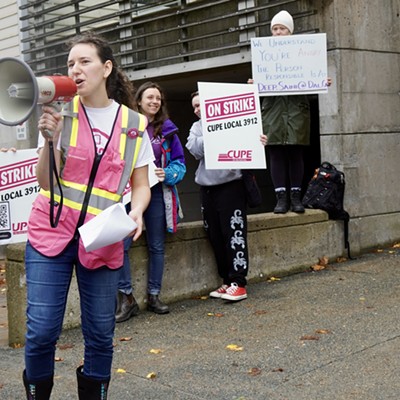It's just a report, not policy yet, but the Stakeholder Consultation Process for a New Renewable Energy Strategy for Nova Scotia, Final Report, by Dal profs David Wheeler and Michelle Adams, makes some good recommendations. It ambitiously states that 40 percent of our energy can be from renewable sources by 2020.
Most notably, the report recommends that the premier commit to establish "feed in tariffs," which will set a standard fair price for renewable energy producers. This move should open up the industry and create significant new supply of green power.
The problem is the makeup of that supply. By new megawatts installed, we're looking at almost 85 percent wind energy in the short term. The other 15 percent---75 megawatts---is to come from biomass, including forest "waste" and farm crops.
It's a strange decision, given the report clearly acknowledges how controversial harvesting biomass from our already abused forests is. Corporate Research Associates found that Nova Scotians give biomass about a three out of 10 on desirability, much preferring wind, solar, tidal, hydro and natural gas. Concerns flooded the consultation process about the threat biomass harvesting poses to our forests.
The Ecology Action Centre is credited in the report with providing an "especially thoughtful" submission on the matter. The group is pleased with nearly every aspect of the report, which recommends decisive, quick action by government. However, the EAC also expressed concern over biomass, and said that it would need to see an overall reduction in clear-cutting and improvements to the Forests Act.
Raymond Plourde, EAC's wilderness coordinator, worries that biomass harvesting will further threaten an already over-harvested resource, and the fish and wildlife that depend on forests for survival. "This could mean a million tonnes or more of additional harvest every year," Plourde says. That's about 133 kilometres squared, a third the size of Kejimkujik Park, every year.
Biomass is often framed as a more efficient use of currently wasted resources. The reality is that while using wood waste makes intuitive sense, most of it is already used in the pulping process. That means those million tonnes would be new clear-cuts. That's how forestry works here---more than 90 percent of all Nova Scotian tree harvesting is via clear-cutting.
Environmentalists are also concerned that with biomass, the whole tree would be used, leaving not even the stump, tree tops and branches that other loggers leave behind to promote regeneration. The province is already developing guidelines to prevent whole-tree harvesting, but these will most likely be voluntary and only applicable to crown land. Large swaths of land owned by individuals and forestry companies would be excluded.
The report by Wheeler and Adams acknowledges these risks but advocates a new, higher standard of biomass harvesting. "It is difficult to see how a gold standard of forestry could evolve from large-scale biomass harvesting," Plourde says. "It would be the lowest value forest product ever produced in Nova Scotia."
So why would Wheeler and Adams recommend such a controversial, potentially destructive source of energy? One reason is cost, the goal being to keep our power bills reasonable. This goal is especially important for low income households. Biomass is cheap because it requires very little in the way of new infrastructure, unlike wind or solar or tidal.
Cost was clearly an important consideration, and the steering committee includes Andrew Waugh of the Affordable Energy Coalition. Or, it did include Waugh, until he resigned on November 13, citing disappointment with government's failure to meaningfully include the poor in its energy efficiency efforts.
Despite the loss of Waugh, Wheeler and Adams report that, "In order for the renewable energy strategy to not disadvantage low income Nova Scotians, and in order for the costs of the strategy to be minimized (to protect all consumer groups), it is essential that the activities of the new Efficiency Nova Scotia Corporation pay adequate attention to all consumer groups' interests and needs."
But Michelle Adams gives me another reason to include biomass. "We can't be opinion-based," she says. "Our expertise is stakeholder consultation." In the case of biomass, while no consensus has yet been reached, a case was made by some stakeholders that it can be done without hurting the integrity of the forests.
The report notes that the pursuit of biomass is "contingent on the ability of stakeholders to come together in a consensual way," which has yet to happen. "That's up to the Department of Natural Resources," Adams says. "If the questions around biomass can be answered, move forward, otherwise don't."
















